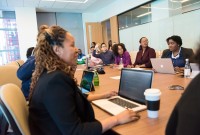- Home
- Business Processes
- Industry Knowledge
- Aerospace Industry
- Automotive Industry
- Banking Domain
- BFSI Industry
- Consumer/ FMCG Industry
- Chemicals Industry
- Engineering & Construction
- Energy Industry
- Education Domain
- Finance Domain
- Hospitality Domain
- Healthcare Industry
- Insurance Domain
- Retail Industry
- Travel and Tourism Domain
- Telecom Industry
- Leadership Skills
- eLearning
- Home
- Leadership Skills
- Leadership Theories
- Role Theory of Leadership
Role Theory of Leadership
Role theory is a concept in sociology and the role theory of leadership borrows these concepts to explain how people adapt to specific organizational and leadership roles. How the leaders and followers in an organizational context define their own roles, define the roles of others, how people act in their roles and how people expect people to act in their roles within the organization.
What is Role Theory?
Role Theory is a perspective in sociology and social psychology. Role Theory proposed that human behavior is guided by expectations held both by the individual and by other people. The expectations correspond to different roles individuals perform or enact in their daily lives, such as secretary, father, or friend. The model is based on the observation that people behave in a predictable way, and that an individual’s behavior is context specific, based on social position and other factors. Each social role is a set of rights, duties, expectations, norms and behaviors that a person has to face and fulfill. Roles are occupied by individuals, who are called "actors".
Role Theory of Leadership:
Role theory as it relates to organizational leadership is how the leaders and followers in an organizational context define their own roles, define the roles of others, how people act in their roles and how people expect people to act in their roles within the organization. The basic assumptions is that the leaders often define their own roles within an organization based on the how the employees see the leader’s role. This theory is based on the assumptions from social role theory that people define roles for themselves and others based on social learning and reading and they form expectations about the roles that they and others will play. People also encourage others within their social circle to act within the role expectations they have for them and they themselves try to act within the roles they adopt.
How it Works?
Associated with every work environment is a set of activities or roles that are defined as potential behaviors to be performed in accordance with a specific job. Within organizations, there exist both formal and informal channels to convey these expectations about leader's role. Formal role theory reveals itself through policies and positions set by upper management. Examples of formal channels are leadership values training, explicit leadership behaviors at different levels/bands, organizational culture, training sessions, mentoring by senior managers, and so on.
Informal role theory reveals itself through the expectations of followers. Employees have internal representations about the role of leaders, based on what they read, discuss, hear, observe and so on. They consciously or unconsciously send these expectations to their leaders, acting as role senders, for example forwarding an important customer escalation mail to the manager for decision and guidance in-spite of employee knowing the desired actions to resolve the same. This balancing of decisions employees take upon ourselves and the ones that they leave on their leaders pass these subtle expectations to the leader. Leaders get influenced by these signals, and will generally adapt and follow these, playing the leadership role that is put upon them by their followers.
Role Theory Terms:
Role expectations of a leader can vary from very specific to a broad idea within which the leader can define their own style. Given below are definitions of some common terms used in context of Role Theory of Leadership.
Role Set refers to any feature of the organization that is able to send role expectations/requirements and role pressures to the manager.
Role expectations refer to the degree to which all members of the manager's role set develop beliefs and attitudes about what the manager should and should not do as part of his/her role.
Sent role refers to the fact that role expectations are sent to the focal person (e.g., manager).
Role pressures refer to the numerous influence attempts directed at the focal person that make up the process of role sending.
Role forces are regarded as psychological forces of some magnitude and direction that result from sent pressures by role senders and are the immediate source of the manager's motivation to behave.
Role behavior is a system relevant behavior that is performed by one who is an accepted member of the system, and whose behavior is reinforced by the formalities of the organization.
Role Conflicts: According to role theory, role conflict is a possible experience for leaders within a business or organization. When the employees in a business have a set of expectations on the role of the leaders that are different from what the leaders accept as their role, role conflict can occur. Role conflict can also occur when different people have differing expectations of their leaders. It also happens when leaders have different ideas about what they should be doing compared to the expectations of followers or management. Similarly role conflict can also occur when a leader feels they should be performing a certain role but employees expect the leader to fill a different role.
Related Links
You May Also Like
-
Symbolic Interaction and Social Change
George Herbert Mead, an American philosopher, affiliated with the University of Chicago founded the theory of symbolic interactionism. A major aspect of this is that people interact by symbols both verbal and non-verbal signals and every interaction makes a contribution to the mental make-up of the mind thus every interaction with someone, changes you and you go away a different person signifying that humans and change go together.
-
Idiosyncrasy Credit Model of Leadership builds upon the awareness that when the emergent leader meets the team's expectations, idiosyncrasy credits are awarded. These credits depend on how the leader fulfilled follower's expectations and what is the impact of the leader's decisions on the follower. When the balance of credits shifts, another leader will emerge.
-
Participative Leadership Theories
Participative leadership theories rely on the involvement of different participants and suggest that the ideal leadership style is one that takes the inputs of others into account. Participative leaders encourage participation and contributions from group members and involve them in the decision-making process. Participative leadership tries to achieve through people, teamwork and collaboration.
-
Certain generally accepted truths or principles of communication are important to consider when communicating with others. These principles hold true for all people in every culture. By understanding these principles, you will experience greater communication effectiveness. An effective communication system is one that achieved its objectives. Communication is effective where there are no barriers to communication.
-
Trait Theory of Leadership is based on the assumption that people are born with inherited traits and some traits are particularly suited to leadership. The theory aims to discover specific leadership & personality traits and characteristics proven to predict the likelihood of success or failure of a leader.
-
Behavioral Theories of Leadership
Behavioral Theory of leadership is a big leap from Trait Theory, as it was developed scientifically by conducting behaviour focused studies. The theory emphasizes that leadership capability can be learned, rather than being inherent. This theory is based on the principle that a leader's behaviors can be conditioned in a manner that one can have a specific response to specific stimuli.
-
Transactional Theory of Leadership
Transactional leadership theory is based on the concept of rewards and punishments. The transactional management approach assumes that the desires of the leader and follower are different and leaders give followers something in exchange for getting something they want. Transactional leaders expect followers to be compliant and focuses on structure, instruction, monitoring, organization, or performance to get tasks completed on time.
-
Functional leadership theory addresses specific leader behaviors that are expected to contribute most to the organizational effectiveness by focusing on how the leadership process occurs. The leader should ensure that all needs of the group get addressed.
-
Transformational Theories of Leadership
Transformational leadership theories focus on the leadership approach where the leader encourages, inspires employees to innovate and create positive and valuable organizational change. A transformational leader works towards “transforming” the culture to one that cultivates trust, mutual admiration, loyalty, and respect with the end goal of developing followers into leaders. Transformational leaders are known to be visionary, inspiring, daring, risk-takers, and thoughtful.
-
The development of teams is an ongoing process because the composition of the team may keep on changing. The new members may join and the old members may leave the team. The team members pass through several stages for the development of the team and there has been a lot of research to identify these stages. In this article, we discuss the common theories of team development.
Explore Our Free Training Articles or
Sign Up to Start With Our eLearning Courses

About Us
Learning
© 2023 TechnoFunc, All Rights Reserved










